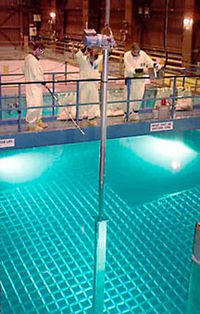
Photo from wikipedia
Abstract Correlation of the fission product Cs-137, U, and Pu with burn-up has been used to develop a method for determining the U and Pu contents of items originating from… Click to show full abstract
Abstract Correlation of the fission product Cs-137, U, and Pu with burn-up has been used to develop a method for determining the U and Pu contents of items originating from 30 spent fuel assemblies (SFAs), which became unusable due to an event in 2003 at Paks Nuclear Power Plant (NPP), Hungary. A mixture of broken fuel rods, pellets, and parts of the cladding were repacked into 72 canisters, whose nuclear material content was to be determined. In this paper, the method has been updated for scanning Cs137 activity and the Cs134/Cs137 ratio along the canisters in 100 s real time intervals by an HPGe detector using a narrow collimator. The effect of mixed burn-up and the irregular fuel geometry was taken into account by using the so-called infinite energy method. The absorption correction factor seems to be constant for all canisters. This is probably due to the overwhelming effect of the thick absorbing water layer in front of canisters lowered down into the service pit, where the measurements were done.
Journal Title: Progress in Nuclear Energy
Year Published: 2019
Link to full text (if available)
Share on Social Media: Sign Up to like & get
recommendations!